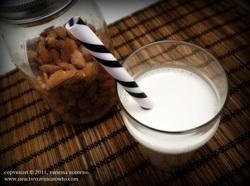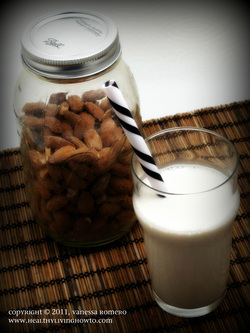There are compelling arguments for and against the consumption of dairy products. Whether it's an animal rights issue or a health issue, it's easy to find dairy-free alternatives. Cow's milk and its by-products are actually quite easy to cut out of your diet. Many recipes can be made by substituting cow's milk with almond milk or coconut milk, without a change in flavor or consistency. Goat's milk is believed to be easier to digest and less allergenic, which makes goat cheese an excellent alternative. If you haven't tried the different varieties of goat cheese you don't know what you are missing.
 If you are unsure if dairy if affecting your health, there is one way to find out, give it up. You can do a dairy-free challenge by abstaining from all dairy products for about thirty days. On day thirty-one, reintroduce dairy, paying close attention to any signs of sensitivity. I have done this challenge myself and noticed no difference in my health during the thirty days, however, what I noticed when I reintroduced it was interesting.
If you are unsure if dairy if affecting your health, there is one way to find out, give it up. You can do a dairy-free challenge by abstaining from all dairy products for about thirty days. On day thirty-one, reintroduce dairy, paying close attention to any signs of sensitivity. I have done this challenge myself and noticed no difference in my health during the thirty days, however, what I noticed when I reintroduced it was interesting.
I show no signs of intolerance to having heavy cream (grass-fed, pasteurized, non-homogonized) in my morning coffee. Some days I have an afternoon cup of java as well with no noticeable ill effects. Now, if I have some form of dairy (cheese, yogurt, sour cream) with my breakfast and again at dinner, I will almost always go to bed bloated and gassy. So for me, there seems to be a limit with how much dairy my digestive system can handle. Almost always, the day after having more dairy then I should, I wake up in the morning with watery “sticky” eyes. For a long time I attributed this to seasonal allergies, which I now have been able to trace back to too much dairy.
 I am not an animal rights activist and enjoy meat with the best of 'em, however, I can't write about dairy without a quick note about farming practices and quality of conventional dairy products. Instead of me writing about it, I will leave it to Jonny Bowden, Ph.D., CNS and author of The 150 Healthiest Foods on Earth. Here's what he has to say…
I am not an animal rights activist and enjoy meat with the best of 'em, however, I can't write about dairy without a quick note about farming practices and quality of conventional dairy products. Instead of me writing about it, I will leave it to Jonny Bowden, Ph.D., CNS and author of The 150 Healthiest Foods on Earth. Here's what he has to say…
In the modern factory farm – which is truly a farm in name only – cows are milk and beef production machines that exist to turn corn and grain into milk and meat as quickly as possible. Since the natural food of cows is grass, the resultant situation is no less than a biological absurdity, akin to keeping lions alive on a diet of chocolate chip cookies. A concentrated corn diet can give cow acidosis, which can lead to a general weakening of the immune system that leaves the animal vulnerable to a host of horrible feedlot diseases. In addition, with the intensive production schedules, it's common for the modern dairy cow to produce many times the number of pounds of milk they would produce in nature. Growth hormones and unnatural milking schedules cause dairy cows' udders to become infected. To prevent this, factory-farmed cows are routinely given large doses of antibiotics, the residue of which, along with that of the steroids and growth hormones they are given, invariably wind up in the milk and meat they produce.
 If you are ready to reduce your dairy consumption or give it up completely for a month, before you go and buy an alternative milk product that has synthetic additives, thickeners, and gut irritants like carrageenan, take a shot at making it. It will be healthier for you, taste better and cost a lot less. I regularly make coconut milk and almond milk at pennies on the dollar.
If you are ready to reduce your dairy consumption or give it up completely for a month, before you go and buy an alternative milk product that has synthetic additives, thickeners, and gut irritants like carrageenan, take a shot at making it. It will be healthier for you, taste better and cost a lot less. I regularly make coconut milk and almond milk at pennies on the dollar.
When I started experimenting with almond milk, I used Blue Diamond Almond Breeze. I didn't drink it straight up, but would use it to make protein shakes or mix with my “greens” supplement. A small carton, which provides four, eight ounce servings, costs anywhere between $1.99-$2.49 where I shopped. I thought it tasted good until I made my own. I tried a couple different brands, like the Trader Joe's brand, cheaper, but disgusting, and Pacific Natural Foods, palatable, but nothing special.
After doing a little research, I found making almond milk is super simple and requires only two ingredients: almonds and water. Compare that to the ingredients in the Almond Breeze: almondmilk (filtered water, almonds), calcium carbonate, tapioca starch, sea salt, potassium citrate, carrageenan, sunflower lecithin, natural flavor, vitamin a palmitate, vitamin d2 and d-alpha-tocopherol (natural vitamin e). And let's not forget the cost savings!
Cost Comparison of Four 8oz. Servings
Homemade Unsweetened Almond Milk = $0.44
Blue Diamond Unsweetened Almond Breeze = $1.99-$2.49
Cost Savings = 78%+
*I buy a 3 lb. bag of raw almonds at Costco for $9.99
Servings 8
Ingredients
- 1 c. Raw Almonds
- 8 c. Cold Filtered Water, Divided
Directions
- Place one cup almonds in a mason jar and cover with water.
- Loosely cover and let soak overnight or 8-12 hours. Rinse and drain.
- Place soaked almonds and 4 c. fresh cold filtered water in VitaMix or high-powered blender.
- Process on high for 3-4 minutes.
- Strain through mesh sieve lined with a cheesecloth or linen towel over a large bowl.
